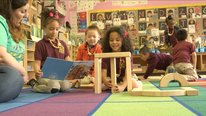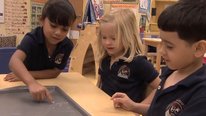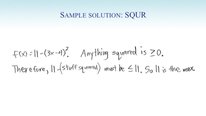KIJU LEE
Case Western Reserve University
TAG-Games
This video presents latest upgrades made on the TAG-Games technology that integrates music and sound into the game design. We explores the role of auditory feedback in the cognitive performance by designing a variety of games incorporating music making and playing into the geometric games.
TAG-Games
This video presents latest upgrades made on the TAG-Games technology that integrates music and sound into the game design. We explores the role of auditory feedback in the cognitive performance by designing a variety of games incorporating music making and playing into the geometric games.
-
 Early Math is Big
Early Math is Big
Cody Meirick
-
 An Early Childhood STEM Professional Development Model
An Early Childhood STEM Professional Development Model
Alissa Lange
-
 Cognitive and Neural Correlates of Spatial Thinking
Cognitive and Neural Correlates of Spatial Thinking
Emily Grossnickle
-
 Zoombinis
Zoombinis
Katie Stokinger
-
 Assessing Secondary Teachers' Algebraic Habits of Mind
Assessing Secondary Teachers' Algebraic Habits of Mind
Ryota Matsuura
-
 Science Fairs Under the 'Scope
Science Fairs Under the 'Scope
Abigail Levy
5989 Views
Public Discussion
Continue the discussion of this presentation on the Multiplex. Go to Multiplex
5989 Views
Related videos you might be interested in...
-
 Early Math is Big
Early Math is Big
Cody Meirick
-
 An Early Childhood STEM Professional Development Model
An Early Childhood STEM Professional Development Model
Alissa Lange
-
 Cognitive and Neural Correlates of Spatial Thinking
Cognitive and Neural Correlates of Spatial Thinking
Emily Grossnickle
-
 Zoombinis
Zoombinis
Katie Stokinger
-
 Assessing Secondary Teachers' Algebraic Habits of Mind
Assessing Secondary Teachers' Algebraic Habits of Mind
Ryota Matsuura
-
 Science Fairs Under the 'Scope
Science Fairs Under the 'Scope
Abigail Levy

Brian Drayton
Hi, seems like a very fruitful technology interface. I could not tell from the video what sort of cognitive assessment you are focusing on. Can you say a bit more about your current research questions?
Kiju Lee
Assistant Professor
Hi Brian,
Thanks for your question. We are currently in the second phase of technology development exploring a variety of game design ideas. Our video presented in the last year’s NSF STEM Showcase include our preliminary version of the assessment games, aiming to measure cognitive problem solving, hand-eye coordination, and short-term memory skills. Here is the link in case you want to check it out: http://resourcecenters2015.videohall.com/presen...
I would be happy to provide further details if you are interested!
Thanks,
Kiju
Victor van den Bergh
Project Manager
Dear Kiju and your team,
This looks like a very interesting project and I really like the way that you are incorporating play in your work. As an evaluator, I am curious to hear about how you are measuring the impact of your technology on your participants’ cognitive performance. Do you use surveys and interviews, or do you rely mainly on data you collect using your software? Who is your target audience? This technology looks very kid-friendly and I would imagine that children would find it to be very engaging! Thank you for sharing your work.
Kiju Lee
Assistant Professor
Thank you, Victor! We mostly rely on automatically measured data from the blocks, including time and accuracy of each manipulation steps, speed of motion, dominant frequency of motion, etc. TAG-Games are being developed to serve as a hardware platform that can be used for cognitive assessment and training and/or learning. Therefore, depending on the target applications, the game can be differently designed at the software level. Our earlier work focused on automated cognitive assessment in adults and children (4-8 years old) and we are currently extending our scope to learning and training games with programmable sensory feedback. The presented work is one of them. Please let me know if you have any other questions/comments!
Karen Purcell
Project Director
HI Kiju and team,
Thank you so much for sharing your work. The use of play in measuring cognitive performance is exciting and innovative. Can you expand a bit more on how this technology has the potential to broaden participation in STEM (this year’s theme for the showcase)? Do you plan to add specific learning curricula? In what settings do you plan to implement the technology? I’d love to learn more.
Kiju Lee
Assistant Professor
Hi Karen,
Thank you for your question. Yes, STEM learning is one of our target areas. These programmable blocks can be integrated with computerized games to teach specific STEM contents. For example, each block may be programmed to represent a number or an arithmetic operator to convey simple mathematical contents. The blocks may be programmed to be logic gates or electronic components to deliver concepts of electronic circuit design. We are hoping that this technology can serve as a platform for researchers and educators and allow them to customize the games based on their needs.
Joseph Wilson
Managing Director
#teamKiju – watching the video made me want to purchase what you had created! Are there specific age ranges of users that you are focusing on? How do you envision this would be integrated into classrooms? (Also – I really liked the background music — who was it?)
Kiju Lee
Assistant Professor
Hi Joseph,
Thanks for stopping by! We are focusing on two populations, children (including preschool to school-aged children) and older adults (65+). We are in process of developing interactive games designed for cognitive assessment, training, and learning. For learning, we are designing a variety of games that can be used in an informal educational settings to teach fundamental mathematical and physical concepts as well as technology and engineering. While the technology itself can be used to deliver the educational contents, building such blocks, with integrated sensors and other electronic components using a hardware kit and instructional materials, can also be a great tool for teaching STEM contents in a more engaging and interactive way.
Further posting is closed as the showcase has ended.